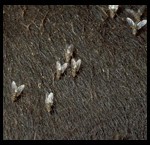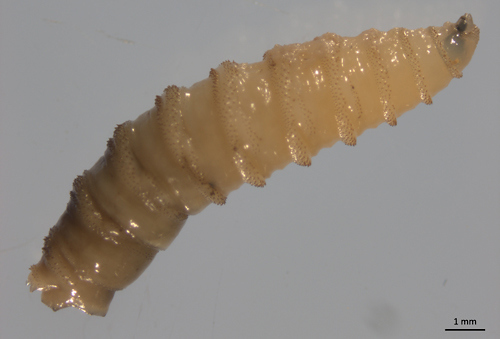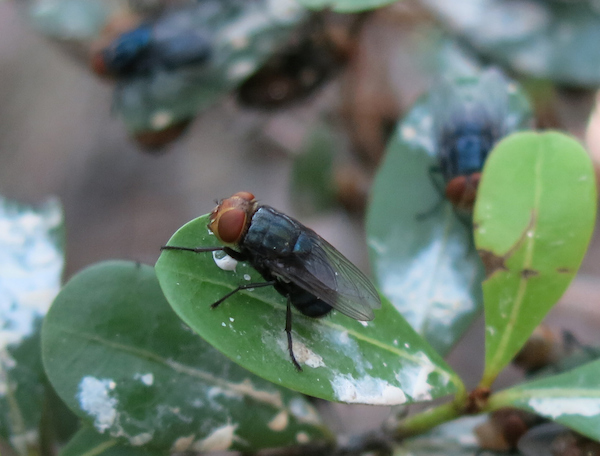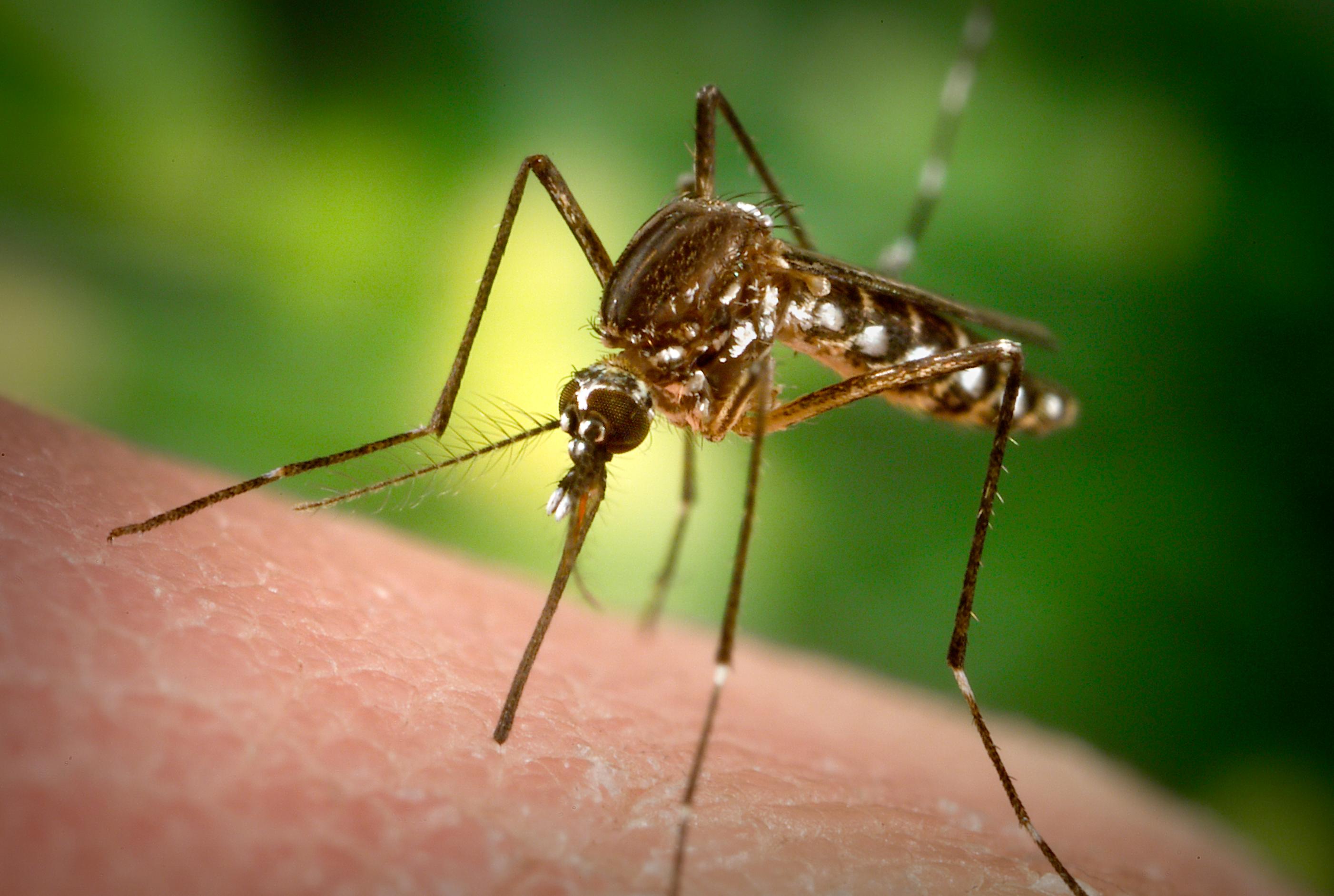Description:
The adult horn fly is 3-5 mm long with piercing/sucking mouthparts that are painful to cattle. The male and female horn flies both take bloodmeals multiple times a day (20-30). The adult horn flies stay in continual contact with the cattle, resting on them between feedings. They can be seen on the withers, back and side of the cattle and will move to the belly during the hottest parts of the day.
Eggs are laid exclusively under the edges of fresh dung pats minutes after defecation.
The larvae develop for 1-2 weeks in the manure pat before pupating in dry soil. The larvae are off white in color and have a tapered appearance on one end and rounded on the other end.
Horn flies diapause as pupa in temperate latitudes, which means they spend the winter as pupa to increase survivorship.
Infested cattle react by licking their backs, twitching their flanks, switching their tails, and kicking at their bellies with their hind legs. Horn flies are more prevalent in the spring and the fall with a drop in the population during the height of summer heat in Texas and during the winter months.
Animals attacked:
Cattle, bison and water buffalo, horses and other large mammals
Veterinary Impact:
In addition to the excessive number of painful bites that occur on a daily basis, the lesions can lead to secondary infections and cosmetic defects in tanned or dyed leather.
Horn flies occur mostly on the cow and usually only by incident on the calves. Not treating mama cows can lead to a 12% decrease in the average daily growth rate of nursing calves. The growth rate of yearling stocker cattle and lactation rates of dairy cows may decrease by about 16%. Metabolic and behavior responses indicate that horn flies increase the amount of energy spent by cattle when defending themselves, leaving less energy available for growth.
Disease Transmission:
Horn flies have been implemented as a developmental vector (carrier) for Stephanofilaria stilesi, a spirurid nematode that causes stephanofilariasis in cattle. Stephanofilariasis is a granular dermatitis that occurs mainly on the belly, scrotum, prepuce and udder of cattle in the western United States.
Control:
The most effective way to control horn fly populations is to take an integrated pest management approach to both the adults and larvae. The horn fly’s ability to thrive allows for large densities in a small amount of time and just treating for the adults will not decrease the infestation. The best approach is to use several methods at once, focusing on source reduction.
Three general approaches to reduce problems include:
1) Prevent breeding by making manure unavailable or too dry or wet for the larvae to survive or kill the larvae before they become adults
2) Kill adults before they cause harm or start to produce eggs
3) Exclude adults entrance by using screens or other barriers
Facilities housing animals should be designed for easy removal of manure and cleaning of stalls frequently. Waste should be disposed of properly by either burial, spreading in a thin layer (less than 3 cm) on open fields, submersion in water, or aerobic composting.
Manure accumulation in pastures should be minimized by spreading and breaking of manure pats so that they dry faster and become unsuitable for larval development. Also, rotating pastures allows for less manure accumulation in one area.
Beneficial organisms such as predators, parasites and natural competitors occur naturally in the breeding locations of the horn fly larvae. These organisms kill the eggs, larvae and pupae of the horn flies providing assistance to the cause. Predatory mites, beetles, and other fly larvae feast on the developing horn fly larvae. Parasitic wasps, referred to as parasitoids, are particularly effective. The female wasp seeks out a host (horn fly pupa) in which to lay her egg. After finding a host, she drills into the puparium (outer cover of the pupa) with her ovipositor and deposits one or more eggs. The wasp probes the pupa twice, once to kill the horn fly larva and a second time to lay an egg. The developing wasp larva consumes the horn fly larva and then an adult wasp emerges from the puparium. Dry breeding grounds will encourage beneficial insect and mite development. Some parasitoid wasps can be purchased commercially to enhance the number of wasps present on your property.
Larvicides provide control against developing larvae. Some products can be sprayed directly to the infested manure pats while others can be administered as a feed additive or bolus. Many of the larvicides on the market are known as IGR, insect growth regulators, and were developed specifically for horn flies and other filth flies developing in the manure. The active ingredient within IGRs target just the developing flies and have little to no affect on other insects or mammals. The active ingredient gives the developing fly larvae a false sense of chemical production, this makes the larvae think they have successfully completed development and they will continue on to the pupal stage. Since they have not completed development many will never emerge from the pupal stage and others will emerge but the exoskeleton will not be able to harden and the fly will die due to exposure to the environment.
Trap options are limited for horn fly adults*. An outdoor walk-through trap has been shown to give promising results if utilized on a daily basis by the cattle. The trap is designed to knock off the horn flies upon entrance, the flying horn flies become trapped inside the walls by the use of inverted slats that prevents them from flying out.
Adulticides are a plenty when it comes to horn fly control. Most products on the market for livestock fly control were developed for horn flies. The constant association with cattle provides more ways to treat for them. Topical insecticides applied directly to the animals consist of ear tags, residual livestock sprays, pour-ons, dust bags, back rubbers, oilers or wipe-ons.
Publication provided by University of Missouri-Columbia Entomology






